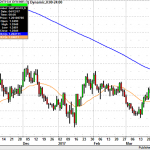The euro bounced after being drilled to support in the $1.1930 area post-FOMC yesterday. The recovery has not been derailed by a shocking miss on the preliminary April CPI. Headline CPI slipped to 1.2% from 1.3%, but the more meaningful miss was the slump in the core rate to 0.7% from 1.0%. Recall that the core rate bottomed at 0.6% three years ago.
Sterling is also enjoying relief from its recent slide. It is trying to snap a six-day slide. In each of the past two weeks, sterling has managed to close higher in one session. Today may be the session for this week. To do so, sterling has to shrug off the service PMI. Although it rose, the gain was less than expected. The April service PMI rose to 52.8 from 51.7. The market expected 53.5. Given the disappointment (decline) in manufacturing, the better construction PMI, and today’s service reading, the composite was sure to disappoint. It improved to 53.2 from 52.4, missing the recovery to 53.7 as expected.

The Australian dollar is higher for a second session. It has been helped today by stronger than expected data in the form of a larger than expected March trade surplus (A$1.57 bln vs. expectations for A$865 mln) and building permits up more than twice as expected (2.6% vs. 1.0%). Today is the first session since April 19 that the Australian dollar has risen above the previous day’s high. Initial resistance is seen near $0.7550 and then $0.7580.
The yen is firmer but largely sidelined. After trying to push through JPY110 unsuccessfully for a third session, the market has pushed the dollar toward JPY109.50.
Global equities are trading heavily after US losses following the FOMC meeting. The MSCI Asai Pacific Index was off (~-0.15%) for a third consecutive session. China, Australia, and Thailand managed to buck the trend and post modest gains. Foreign investors, which had turned buyers of South Korean equities this week after heavy sales in late April turned back to the sell side today and offset the purchases conducted in the first half of the week.













Leave A Comment